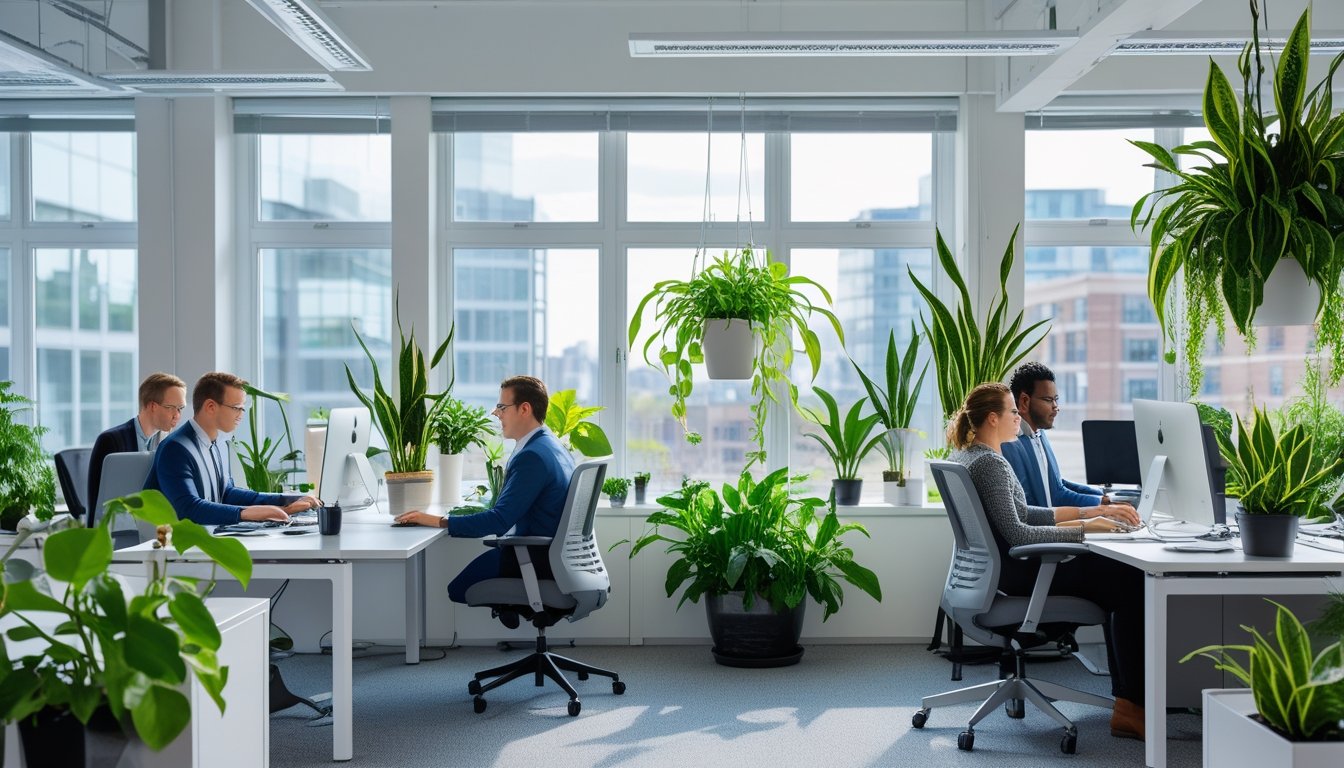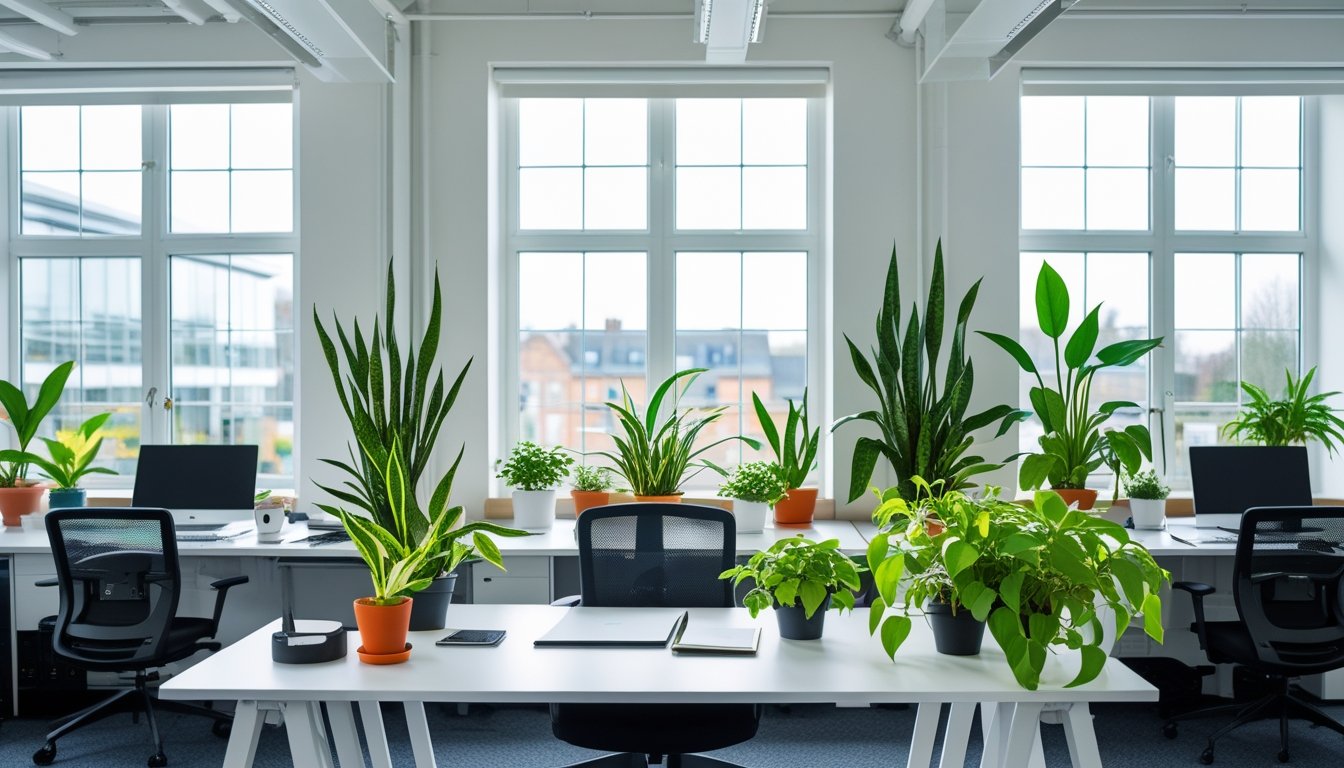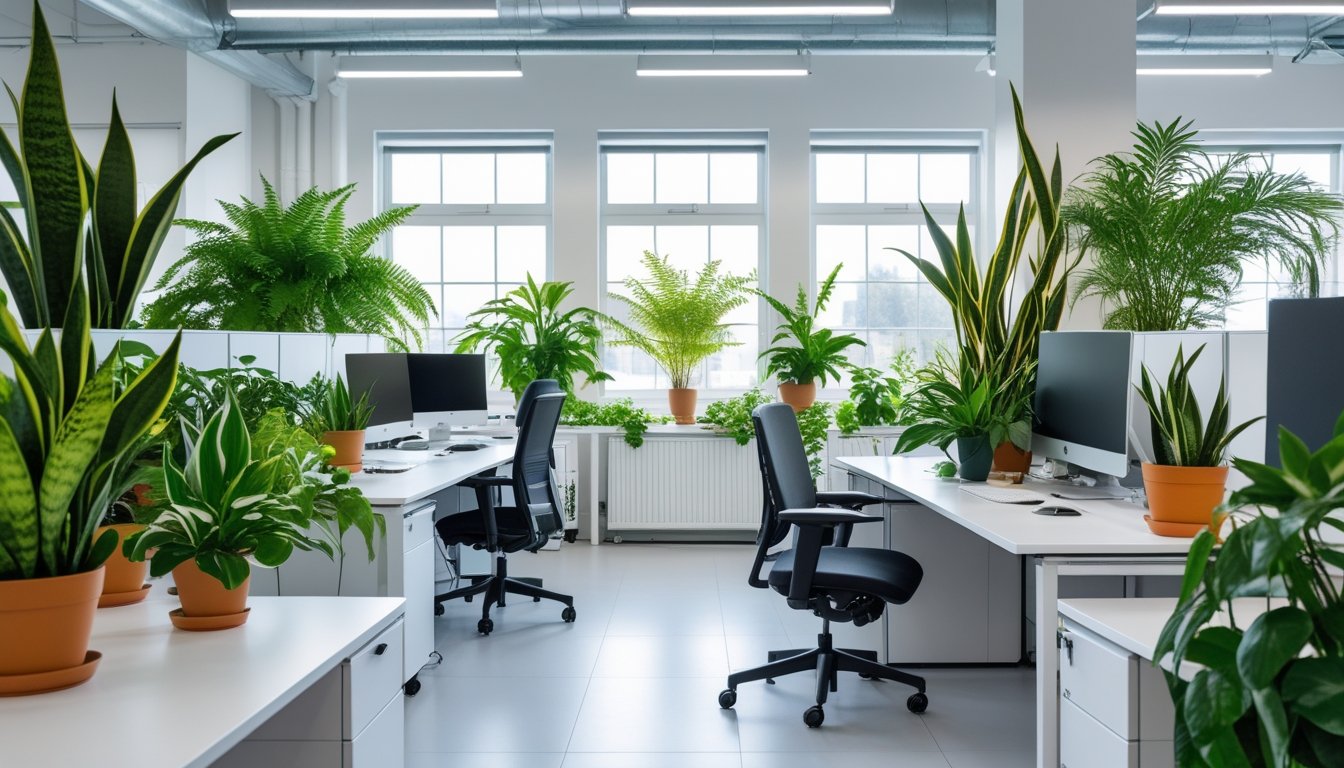Late updated: 20 Jun 2025 08:06
Written by: Amber Collins
The Benefits Of Green Office Plants For UK Workspaces: Enhancing Productivity and Well-being
The modern UK workplace is transforming, and plants play a vital role in this evolution. Employees can enjoy a more vibrant and welcoming environment with the introduction of greenery into the office. Green office plants are not only aesthetically pleasing but also enhance productivity and well-being by purifying the air, reducing stress, and boosting overall morale. Connecting with nature within our workspaces offers a much-needed respite from the hustle and bustle.

We have often felt the mental fatigue that accompanies long work hours. Transforming our office spaces with plants can be a game changer. Varieties like spider plants, peace lilies, and bamboo palms are leading the charge, improving the quality of air and providing tangible health benefits. This green transformation aligns with a growing commitment to sustainable and health-focused workplace practices.
The practical implementation of office plants requires thoughtful planning to maximise their benefits. We should consider factors such as light availability, maintenance, and the specific needs of each plant species. By selecting the right plants and integrating them effectively, workplaces can become more inviting while promoting health and well-being.
Key Takeaways
- Green office plants improve air quality and employee well-being.
- Select plants based on light, maintenance, and workplace needs.
- Plants create a more inviting and productive work environment.
Key Benefits Of Green Office Plants For UK Workspaces

Integrating plants into UK workspaces brings numerous advantages. They contribute to enhanced productivity, better air quality, and strengthened employee wellbeing. Let us explore these benefits in more detail.
Enhanced Productivity and Cognitive Function
Office plants are not just for decoration; they play a significant role in boosting productivity and cognitive function. Research indicates that greenery in workspaces can lead to increased employee engagement and job satisfaction. By instilling a sense of biophilia, plants stimulate creativity and focus, essential components for effective work.
Furthermore, the presence of biophilic design elements creates a soothing environment, significantly impacting cognitive abilities. Employees tend to feel more energised and alert when surrounded by nature. Our working memory and attention span benefit greatly from the calming effects of green office spaces.
Improved Air Quality and Health Benefits
Indoor plants are valuable allies in improving air quality within the workplace. They absorb carbon dioxide and release oxygen, creating a fresher environment. Studies have shown that some plants are effective at removing volatile organic compounds (VOCs) and other pollutants, thus enhancing the indoor air quality significantly.
The health benefits are extensive. Employees experience reduced stress levels and better mental health, contributing to lower absenteeism. Improved air quality leads to fewer respiratory issues, promoting overall employee health and ensuring a more productive workforce.
Strengthened Employee Wellbeing and Collaboration
The impact of office plants extends to employee wellbeing, fostering a more collaborative and harmonious work environment. Greenery helps build a positive company culture by enhancing teamwork and collaboration. Employees are more likely to feel relaxed and connected with their team, encouraging open communication and collective problem-solving.
Moreover, the aesthetic appeal of a green workspace has positive psychological effects, such as increased morale and motivation. As we integrate nature into our surroundings, we find ourselves more inclined to work collaboratively, ultimately strengthening our professional relationships and workplace satisfaction.
Practical Considerations For Incorporating Greenery In UK Offices

Incorporating greenery in UK offices enhances worker productivity and promotes environmental sustainability. Key considerations include effective workspace design, mindful energy use, and selecting suitable plants.
Workspace Design and Biophilic Elements
We should prioritise workspace design that integrates biophilic elements, focusing on natural elements like plants to create more inviting environments. Designing layouts that promote greenery can increase both employee satisfaction and productivity.
Incorporating living walls and green spaces is excellent for offices with limited floor area. These add a natural touch without crowding the space. Maximising the use of natural light not only supports plant growth but also improves energy efficiency.
Energy Efficiency and Environmental Awareness
Energy efficiency is crucial when introducing plants into the office. Efficient use of natural light supports plant health and reduces reliance on artificial lighting.
Green buildings can benefit from automated systems that manage energy consumption, providing optimal conditions for plants without excessive energy use. Encouraging environmental awareness through office design can foster a connection between employees and their surroundings, enhancing the overall ethos of sustainability at work.
Choosing Low Maintenance and Suitable Plants
Selecting the right indoor office plants is essential for maintenance simplicity. We must consider low maintenance plants that thrive well in indoor conditions and can cope with variable light and humidity levels.
Ideal choices include succulents and snake plants due to their resilience and minimal care requirements. By opting for these, we reduce the burden on office maintenance teams. This thoughtful selection ensures a green office remains a benefit rather than a burden for staff and management alike.
Frequently Asked Questions

Office plants offer many benefits, from air purification to reducing workplace stress. Let's explore common queries around office greenery to provide clarity on the role plants can play in UK workspaces.
What are the proven advantages of having plants in an office environment?
Plants in the office can improve air quality by filtering out harmful pollutants. They also create a more pleasant environment, which can lead to increased employee satisfaction and well-being. Studies indicate that the presence of plants in an office setting can help reduce noise levels and create a calming atmosphere.
How do indoor plants contribute to employee productivity and well-being?
Having plants within a workspace can boost creativity and focus, contributing to greater productivity. Employees often report feeling more engaged and less fatigued in offices with greenery. The presence of nature, even in small forms, can alleviate the effects of stress and enhance overall mental health.
What are the best types of plants to keep in an office setting for minimal maintenance?
Some of the easiest plants to maintain in an office include spider plants, peace lilies, and pothos. These plants require minimal care, thrive in indirect sunlight, and handle irregular watering well. Their robust nature makes them ideal for the typically fast-paced office environment where care routines might be inconsistent.
Can office plants significantly improve air quality in a workspace?
Certain plants have the ability to filter harmful chemicals such as benzene and formaldehyde. While not a complete solution, the introduction of plants like bamboo palms and peace lilies can contribute to a healthier office air quality. Incorporating these plants into the workspace helps mitigate indoor pollution.
How do green spaces within workspaces impact employee stress and anxiety levels?
Green spaces can substantially decrease stress and anxiety among employees. The presence of plants is linked to reduced tension and anxiety levels. Research shows that workers in environments enriched with plants often report feeling less stressed and more motivated, which contributes to better job satisfaction.
What considerations should be taken into account when introducing plants to a professional office space?
It's important to assess light availability and choose plants that will thrive in the given conditions. Consider any potential allergies among employees and select low-allergen or hypoallergenic plants. Regular maintenance routines should also be planned to ensure that the plants stay healthy and vibrant, adding to the office's aesthetic and functional benefits.
